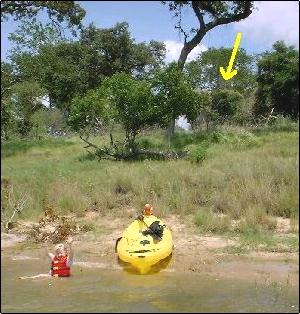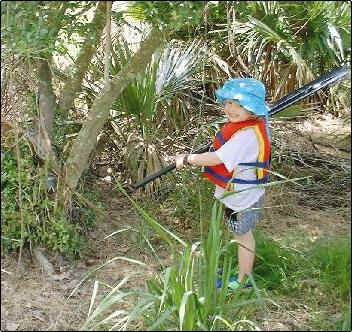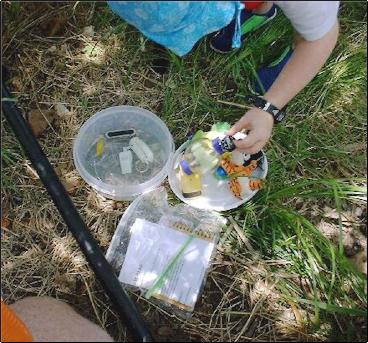| There is a game called Geocaching that is a treasure hunting sport
where you use your GPS receiver to find caches hidden by others. The basic
philosophy is that someone hides a container somewhere on public property,
and then publishes the coordinates. When the cache hunters find the cache,
they are expected to take a treasure, leave a new treasure, and write in
the log book. As of this writing, there are over 14,000 caches hidden
world wide, most of them in the United States. The majority of caches are
hidden in parks and are meant for land lubbers, but there are caches that
are only accessible by boat.
HOW TO GET INVOLVED:
This is an inexpensive sport, all you need is a GPS receiver (mine
cost $100). Everything else is free, just go to
www.geocaching.com and create a
login name. Anyone can hide caches, and anyone can hunt for them.
After a cache is found, the person can log on and record their finding
with a note and even upload some pictures.
HUNTING TIPS:
 1 - Take a
print out of the entire geocache log. Most hiders leave some sort of clue
besides the coordinates, and the finders also give more clues when they
register finding it. If you are out there and can’t find it, it really
helps to have those notes with you. 1 - Take a
print out of the entire geocache log. Most hiders leave some sort of clue
besides the coordinates, and the finders also give more clues when they
register finding it. If you are out there and can’t find it, it really
helps to have those notes with you.
2 - GPS receivers seem to have a
“circle of confusion” when you get to the last 30 feet, in which they read
sporadically, or zero out a distance from where the hider’s gps zeroed. A
technique to overcome this is to stand off 50-100 feet away from where you
think the cache is and read the direction the gps says the cache located.
Then use a compass to sight where it is supposed to be. Then circle around
to another spot and sight from there. This triangulation technique seems
to help improve the accuracy and give a better idea where the cache is.
3 - If you are in a heavily wooded
area, find a spot to take a reading with a clear shot of the sky.
4 - There are plenty of poisonous
snakes here in Texas so I use a walking stick to poke around in the
underbrush.
HIDING TIPS:
1 - The biggest failure of geocache
containers is that they leak and become water logged. Many people have
been using Tupperware containers with the press on lids, and these just
aren’t weather resistant enough to last. Some of the containers that do
well are military ammo boxes and dry boxes meant for sportsmen that have a
gasketed lid. I personally prefer to use a Rubbermaid #3142 Screw Top Jar.
It is a clear plastic container with a waterproof lid that I have tested.
I like the clear containers so that the person that finds the cache can
look inside before opening it - wouldn’t want a surprise in there.
2 - Mother nature and careless cache
hunters have a way of moving stuff out there, so another feature of my
containers is that I bolt a loop to the lid, seal it with marine goop,
 and then tie the container to a tree root. I started doing this after one
of my containers was lost in a flood, and another was lost because the
lake water level was unusually low when I hid the cache, and it floated
away when the water level returned.
and then tie the container to a tree root. I started doing this after one
of my containers was lost in a flood, and another was lost because the
lake water level was unusually low when I hid the cache, and it floated
away when the water level returned.
3 - The GPS “circle of confusion” makes
the last 30 feet a guessing game for the hunters, so I always place mine
near a conspicuous landmark like a tree stump, or large rock. One cache I
hunted for was in a grassy field. That cache was very difficult to find
and took three trips because the grass was very tall and overgrew the
whole area making the container especially hard to find. On the third trip
I accidentally stepped on it, having previously just probed the area with
my walking stick.
TYPES OF CACHES:
Traditional Cache - This is the typical type, a container which
stores treasures and a log book.
Multi-Cache - This is a connect the dots type cache. After finding
the first cache, you are given further coordinates of other caches which
aren’t publicly listed.
Virtual Cache - This is just coordinates of an area, perhaps where
they prohibit geocaching. Devils Tower is a good example, the original
geocache there was removed by the park rangers.
Letterbox Hybrid - There is another game called letterboxing that
uses clues instead of coordinates, and sometimes these are cross posted to
both games.
Event Cache - These are events where the cache coordinates are
published, for a get together.
TRAVEL BUGS:
A recent addition to the game is Travel Bugs. You can purchase dog
tags from the Geocaching online store, and then attach them to a toy or
other object. These are then placed in a cache for other cachers to pickup
and move to another cache. Each travel bug has it's own page with a photo,
description of their mission, and logs of who has picked it up and where
it has gone.
https://www.geocaching.com/track/ - Tracking travel Bugs
INTERESTING CACHES:
There is one cache in Houston which is in plain sight along a
sidewalk next to a bench. The cache is film canister very cleverly hidden
in a log. You sit down at the bench, reach over and pickup the log, pop
the end off and pull the canister out. Inside are a few small treasures
and coins, along with a scroll of paper for a log. -- Another clever
one here in Houston is a film canister with a paper clip bent into a hook.
The canister is then suspended inside the top of a pole which is a sign
post.
https://www.geocaching.com/seek/cache_details.asp?ID=8904
 Early in the
game there was a cache where a guy bolted an ammo box to a tree, and
locked it with a combination lock. The combination was published with the
coordinates, so hunters could open the box when they visited it. This box
was also in plain sight, and one day it was discovered the lock had been
broken but replaced to look like it was locked. It was logged by someone
who said they broke into it because they were curious, read the
explanation note of what it was inside and was going to go get a GPS
receiver later that day to start playing the game. Early in the
game there was a cache where a guy bolted an ammo box to a tree, and
locked it with a combination lock. The combination was published with the
coordinates, so hunters could open the box when they visited it. This box
was also in plain sight, and one day it was discovered the lock had been
broken but replaced to look like it was locked. It was logged by someone
who said they broke into it because they were curious, read the
explanation note of what it was inside and was going to go get a GPS
receiver later that day to start playing the game.
Hiding a cache on a beach is very difficult, the hider of “Pearl” in
Louisiana solved this buy burying a steel rod with 6” above the sand.
After finding the rod the hunter goes 10 feet to magnetic north and then
digs up the container.
https://www.geocaching.com/seek/cache_details.asp?ID=1097
GEOCACHE ONLINE RESOURCES:
www.geocaching.com ---
the main game site
https://www.geocaching.com/track/ --- Tracking travel Bugs
alt.rec.geocaching --- usenet discussion group about geocaching
sci.geo.satellite-nav --- discussion of other gps topics
https://www.brillig.com/geocaching/maps.shtml --- Buxley’s Maps
of all
the geocaches
https://www.fcc.gov/mmb/asd/bickel/distance.html -- Distance
between 2
gps coordinates
https://www.gpsdrawing.com/gallery.htm --- drawing the world with
GPS
https://www.confluence.org/index.php -- the Degree Confluence
Project
https://joe.mehaffey.com/ ---
tons of GPS info
https://www.shortypen.com/geo/
my personal geocaching page |